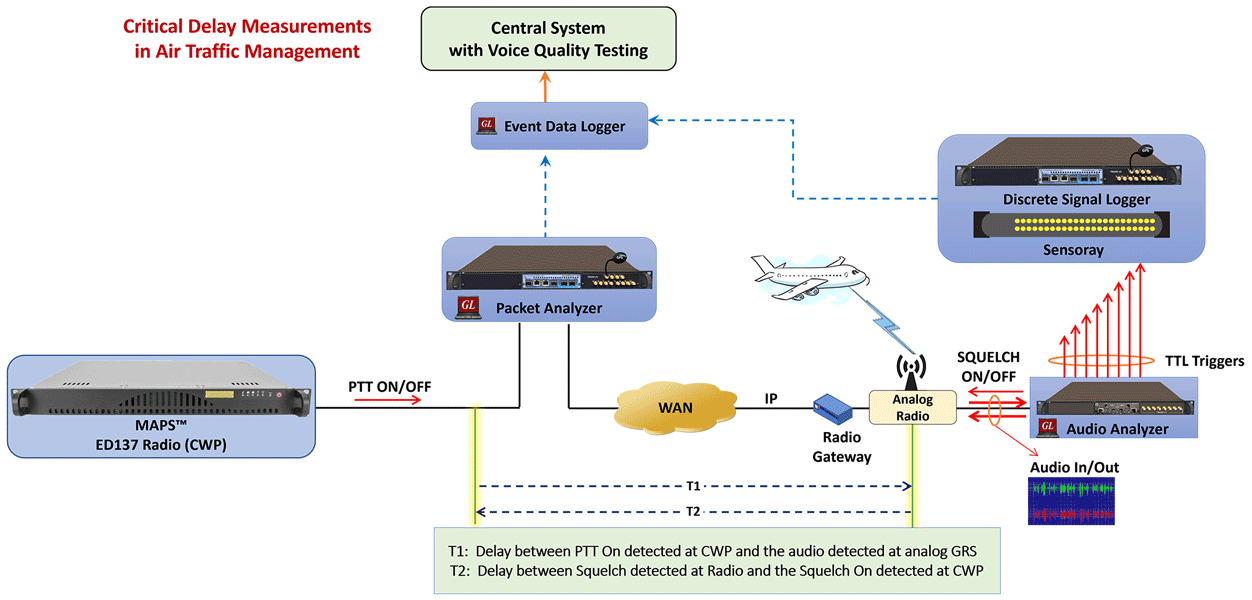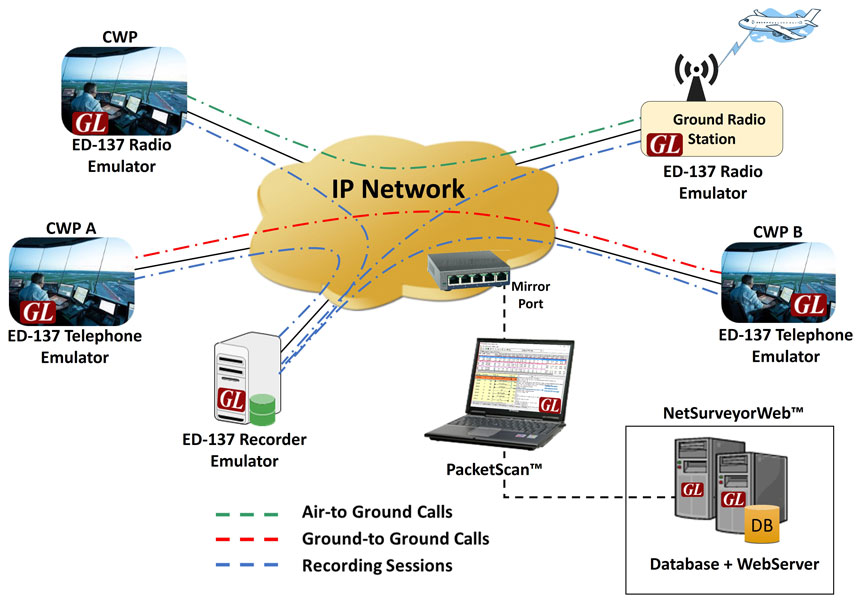GL’s VoIP Test Solutions for Air Traffic Management
Welcome to GL's latest newsletter, where we discuss our Air Traffic Management (ATM) test solutions for testing Analog, TDM, Ethernet, and IP communications networks. Our solutions are adaptable to various global standards.

Air Traffic Management Solution
Overview
GL offers cutting-edge solutions for testing next generation ATM networks. This includes the ability to emulate and load test equipment such as Controller Working Positions (CWP), Ground Radio Stations (GRS), Analog-to-IP converters, Gateways, and more. Components can be accurately tested for timing, performance, and functionalities. The GL test tools for next generation ATM offer signaling and traffic emulation per the ED-137 standards, monitoring the quality of service per ED-138, and providing critical network delay and voice quality measurements.
GL’s ED-137 and ED-138 Voice over IP Test Tools have been widely welcomed by Global Air Navigation Service providers and Radio/Gateway/Recorder companies who have found them to be essential tools during development, functionality testing, performance testing, factory acceptance testing, deployment and field testing.
Measuring the delay in hybrid ATM networks is critical to ensure clear and quick communication between air traffic controllers and pilots. Recognizing, capturing, timestamping, and correlating events at Analog, TDM and IP interfaces are necessary. Delay measurements should be conducted repeatedly to ensure that the device and network under test is performing consistently over time.
GL ‘s Timing Measurements in Air Traffic Management (TM-ATM) test suite accurately emulates endpoints in ATM networks and provides critical timing measurements for various types of delay occurrences in signaling and voice transmission. It includes all necessary hardware deployed across the Air Traffic Management network and software to identify, capture, timestamp, and correlate events at Analog, TDM, and IP interfaces.
This TM-ATM solution is based on GL’s Message Automation and Protocol Simulation (MAPS™) software program. MAPS™ can emulate a wide range of telecom protocols including ED-137 Radio, Telephone, and Recorder. The MAPS™ program runs on Windows® OS and uses the PC’s network interface card to send and receive traffic.
Applications of TM-ATM:
- Delay measurements for:
- Push To Talk (PTT), PTT confirmation, PTT release, PTT release confirmation
- Squelch On/Off
- End-to-end voice delay for PTT, and Squelch
- Main/Standby Tx/Rx transfer
- Main/Standby Tx/Rx transfer confirmation
- Remote Receiver Mute/ Unmute
- Remote Receiver Mute/Unmute confirmation
- Supports for end-to-end Voice Quality measurement using industry standard ITU algorithms (PESQ and POLQA)
- Measure consistency and reliability by doing multiple iterations
- Load test the network to achieve the required Peak Busy Hour and Peak Busy Minute loads
Key features:
- Centralized control and reporting of the tests
- Ability to interface with Analog, TDM and IP based systems
- Customize test suite to measure delay and voice quality between Analog and IP networks
- Automated tests to run multiple iterations for accuracy and consistency
- Timing accuracy using different clock sources - Local clock, GPS, Master, and Slave
- Supports audio/tone transmission and recording/tone detection
- Up to 32 hardware-based filters for wirespeed filtering
- Supports voice detection in IP packets and voice delay calculation
- Measured delays for every iteration are logged to CSV file
- Display live measurement and load statistics. Test results can be exported to PDF file
GL’s solutions include rack mount and portable hardware equipment deployed across the Air Traffic Management network. These include:
- Central Administrative System:
- Controls all the components of TM-ATM test suite and runs the tests to perform measurements
- Calculates the time difference between posted events and reports the precise one-way delay at different points in the network
- ED-137 Radio Emulator:
- Emulates Air-Ground calls (as per ED-137), and multiple CWPs or GRSs
- Can emulate PTT/Squelch, send and record audio to perform end-to-end voice delay and quality measurement
- Emulates all radio events such as Main/Standby Tx Rx switching, Mute/Unmute Receiver etc.
- Packet Filter System:
- Deployed in-line on an Ethernet network
- Provides 32 hardware filters to filter and timestamp the packets of interest at wirespeed
- Packet filtering can be based on Layer 2 (Ethernet), Layer 3 (IP), and Layer 4 (UDP/TCP) headers
- Can generate TTL triggers (1 Microsecond pulse) for each filter passed
- Analog VCS/Radio Emulator:
- Emulates PTT/Squelch and Audio; generates TTL triggers based on PTT On, PTT Off, Audio Start and Audio Detect (On or Off)
- Inject and record analog signals at the VCS and Radio
- Event Decoder:
- Receives filtered packets from Packet Filter System and Control Signal Detector with timestamping
- Processes received packets, sends notifications to the Controller Administrative System
- Detects audio in RTP packets to identify the beginning of voice in the stream
- Control Signal Detector:
- Monitors IO channels of the Sensoray for low-to-high and high-to-low transitions
- Used to filter and forward desired events/frames
- Monitors TTL output from the Analog Radio Controller and Packet Filter System and generates a corresponding IP packet to send to the Event Decoder
- Voice Quality Testing Software:
- Performs end to end voice quality assessment using industry standard ITU algorithms (PESQ and POLQA) across the ATM network
Below is a typical Air Traffic Management network showing the role of emulators and analyzers. GL emulates air-to-ground, ground-to-ground, and recorder interfaces as per ED-137 standards. All IP traffic can be monitored using PacketScan™ and analyzed either locally or remotely using NetSurveyorWeb™ applications.

The sections below briefly discuss GL’s emulators and analyzers used for testing VoIP based ATM network and equipment.
MAPS™ ED-137 Radio emulates air-to-ground calls by emulating either CWP or GRS. ED-137 Radio emulator supports both version B and C of ED-137 volume 1 Radio. Hundreds of CWPs or Radios can be emulated and can generate bulk air-to-ground calls using a single instance/license. Can be used to test functionality and performance of CWP, GRS and Radio Gateways. ED-137 Radio emulator is validated against VOTER versions 4.1.30.1 and 4.1.30.2 volumes for GRS and VCS Radio ED137/1C compliance.
MAPS™ ED-137 Telephone emulates ground-to-ground calls by emulating CWP. Supports both version B and C of ED-137 volume 2 Telephone. Hundreds of CWPs can be emulated and can generate bulk ground-to-ground calls using a single instance/license. Can be used to test functionality and performance of CWP. Validated against VOTER_4.1.30.3 for VCS-Telephony-Interface-Test cases.
MAPS™ ED-137 Recorder emulates recorder interface at GRS and Recorder server as per version B and C of ED-137 volume 4 Recorder. Can be configured as either CWP or GRS or Recorder to emulate recorder interface at that node. Hundreds of CWP/GRS/Recorders can be configured to emulate bulk recording sessions.
PacketScan™ is a protocol analysis software, which offers powerful features to capture and monitor A-G and G-G calls in the ATM network. The application can capture, segregate, monitor and collect statistics such as packet loss, delay, jitter, and MOS on all the captured calls. It can also act as a probe in the network and send Call Detailed Records to a centralized database to facilitate centralized monitoring of the probes/network.
NetSurveyorWeb™ is a web-based dashboard, which displays real-time data. Users can navigate through historical records, filter VoIP traffic, and graphically analyze calls, view the Mean Opinion Score, packet loss, failed calls, completed calls, Post Dial Delay, and more. Users can generate alarms and e-mail notifications to report configured failures in the network.
 Back to Newsletter Index Page
Back to Newsletter Index Page